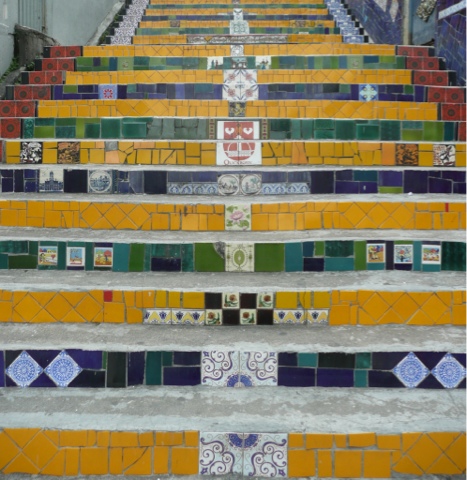Eye-opener
Proposal
Invisible
Copacobana
Rolled into Rio de Janiero bringing along the overcast cloudy weather of Paraty. Luckily we stayed in a hotel for our time there. Two words: buffet breakfast - shaweeet!! We were staying in the Centro district and my first impression of Rio was that it was dingy and smelled of urine and faeces. There are numerous portaloos about the streets and the smells emanating from them are most foul. There also was a huge number of homeless people about and streetwalkers patrolled the streets from as early as 6pm. The city has a big job ahead of it to be able to cater for the volume of people that will arrive for the upcoming World Cup and Olympics. Again I found the city to be safe enough, but then I never tested it by heading out alone, the minimum group size heading anywhere was always about three.
Got the underground to see Ipanema beach, where you cannot swim as the waves are monstrous (apparently it can reach up to 9ft in winter!) and the sound of crashing waves is simply thunderous - that didn't stop the large numbers of surfers though. Water looked a wee bit scummy, not sure if that was entirely due to the force of the breaking waves.
Two mountains called the Dois Irmãos (Two Brothers) rise at the western end of the beach. Beer is sold everywhere on the beach along with the traditional cachaça and coconut milk. There were many people playing football, volleyball, and footvolley, a locally invented sport that is a combination of volleyball and football.
We left Ipanema and moseyed on down to Arpoador beach which is mostly known for being one of the best metropolitan surf spots in Rio de Janeiro. The rock outcropping creates stable left breakers up to 7–10 feet high and a strong riptide creates a quick re-entry but the take-off point is very small and only locals (or visiting professional-level surfers) have a shot at it.
Next stop was Copacobana and I can say that I was completely underwhelmed and unimpressed with that. To be fair it was a Sunday afternoon on an overcast day so there wasn't too many people about and it didn't look postcard perfect - but still I cannot see why there is so much hype over this beach; it looked just like any Spanish beach in Costa del Sol. We also did not actively notice the different beach sections, but again perhaps this was due to the inclement weather.
Every Sunday, the roadway closest to the beach is closed to motor vehicles so locals and tourists can use the opportunity to ride bikes, roller skate, skateboard, and walk along the ocean. We made the most of this and comfortably walked the 4km of Copacabana without experiencing too many heaving crowds.
While in Rio I was supposed to go hang-gliding but sadly it was cancelled on two occasions due to low cloud cover - quite depressing! Instead I did an interesting tour around Favela Rocinha, the largest favela in Rio. It is built on a steep hill and has about 70,000 people living there. Rocinha developed from a shanty town into an urbanized slum. Today, almost all the houses are made from concrete and brick. Some buildings are three and four stories tall and almost all houses have basic sanitation, plumbing, and electricity. It was a real eye-opener and I think everyone who did the tour was touched by what we saw there.
Headed to see Christ the Redeemer who was very shy and hid behind a mountain of cloudy mist for the entire time we stayed up at the peak. I feel honoured (not!) that I am probably only one of a few tourists who came to Rio and could not see the statue as it was practically invisible. Sugar Loaf also showed us no love and hid in a fantastic grey cloud that completely threw my visual senses.
Rio's Cathedral is quite ugly from the outside, it seems to be closely modelled in an Incan style architecture. However from the inside, the four stained glass windows are immense. Each represents a season and are designed to catch the setting sun mduring their specific season. It would have been nice to see on a sunny day, but we made do.
The Escadaria Selarón (aka Lapa Steps) are a set of world-famous steps in Rio. They are the work of Chilean-born artist Jorge Selarón. Originally, tiles for the work were scavenged from various construction sites and piles of urban waste found on the Rio streets. But in later years most of the tiles were donated by visitors from all around the world. Of the over 2000 tiles, 300-odd were hand painted by Selarón. I managed to find the tiles that had been sent from Irish benefactors, and while I had bet Ken that Guinness or perhaps a tacky leprechaun would feature, I had to settle with a non branded Irish stout tile instead - close enough methinks.
The morning we left Rio, Kirsten announced that Pete had finally proposed, after years of him claiming not to be the marrying kind. She spent the entire day beaming and most of the morning retelling the tale to everyone as we all arrived down to a leisurely brekkie in drips and drabs. We all helped them celebrate that evening in our overnight camp in Teresópolis. A nicer couple you could not meet, and I wish them both every happiness in the future.











































No comments:
Post a Comment